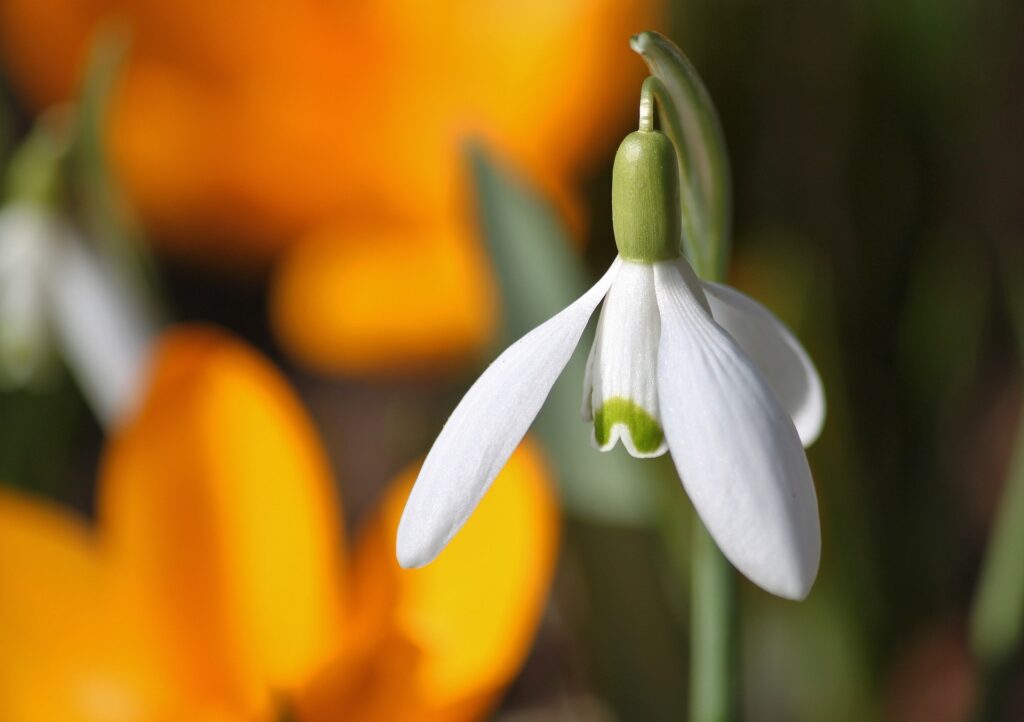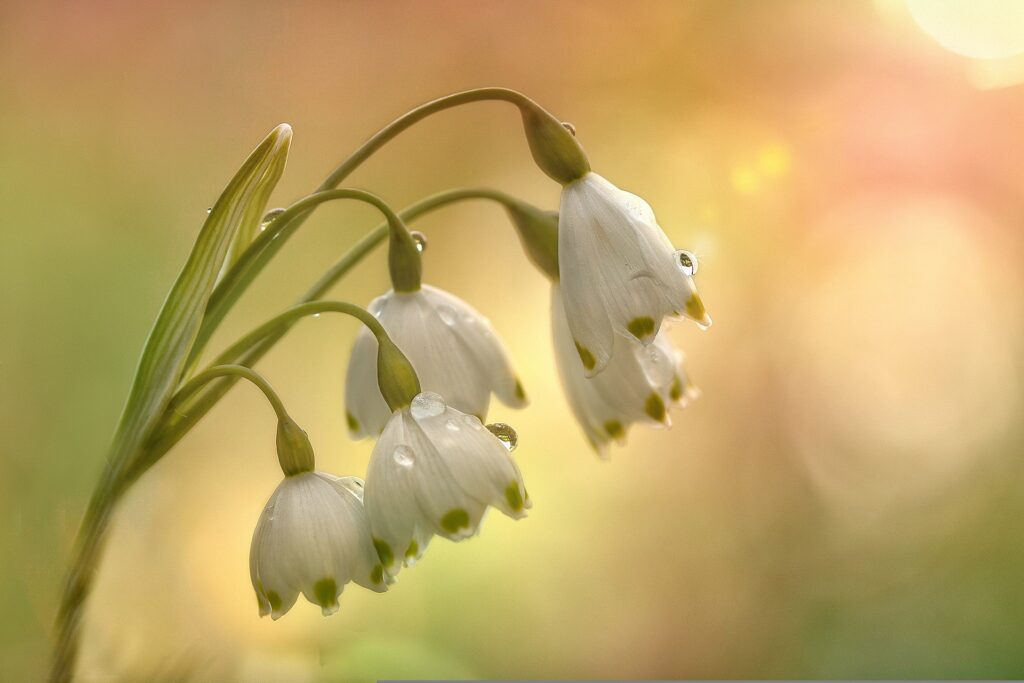Snowdrop Flower Meaning, Spiritual Symbolism, Color Meaning & More
Known as both the Flower of Hope and Death’s Flower, the dainty snowdrop sure is a nebulous so-and-so, but this polar duality is part of their appeal.
Capitalizing on both inviting warmth and grim curiosity, they fascinate us, drawing us in, begging to be studied and poeticized.

It’s small wonder why they’ve come to represent such a wide variety of things.
From doom and gloom to brightness and levity, there are few plants with the sheer symbolic range of the snowdrop.
Diminutive though they may be, these wintry little plants can teach us many things, so let’s give in to this gleeful and grim flower’s gambit, and take a closer look, shall we?
Key Takeaways
- Hope and Rebirth: Snowdrops symbolize hope, rebirth, and the arrival of spring. Their ability to bloom early in the year, often amid snow, represents the resilience of life and the promise of better times ahead.
- Purity and Innocence: White Snowdrops are associated with purity and innocence. They are commonly used at weddings and christenings to signify the beginning of new, pure, and untarnished phases in life.
- Spiritual Renewal: Snowdrops are often symbols of spiritual purity and renewal. They encourage individuals to let go of the past, start anew, and embrace spiritual growth.
- Candlemas Flowers: Snowdrops are also known for their delicate beauty and association with light making them a holiday symbol.
- Loyalty and Consolation: Snowdrops symbolize loyalty and consolation in Victorian flower language. They can be given as a token of support and commitment to a loved one during challenging times.
- Resilience and Perseverance: Snowdrops' ability to push through snow and harsh conditions to bloom early in the year symbolizes resilience, determination, and the strength to overcome adversity.
- Delicate Beauty: Despite their small size and fragile appearance, Snowdrops carry deep and meaningful symbolism. They remind us that even the most delicate beings can bring profound messages of hope and renewal.
The key takeaways from the symbolism and meanings of Snowdrop flowers are as follows:
What Does The Snowdrop Flower Mean?
Despite their decidedly disconsolate droop, the most prominent meaning assigned to the snowdrop is that of hope.
There is something utterly scintillating about catching your first glimpse of a flower in three icy months, and, if it’s native to your homeland, that flower is almost certain to be the snowdrop.
It may still be cold when they pop suddenly from the earth, but they signify the waning of winter and the clearing of the cold for spring’s arrival.
The sight of one won’t stop your teeth chattering, but it will warm your soul a great deal in anticipation of what’s to come.
However, as you’ve gathered from my introduction, the snowdrop isn’t an optimistic sign through and through, so let’s inch a little closer and see if we can’t catch a glimpse of its dark side.
RELATED: Narcissus Flower Meaning, Spiritual Symbolism, Color Meaning & More
Etymological Meaning Of The Snowdrop Flower
As you might have guessed, snowdrop isn’t the official name of this lovely plant.
If you want to impress the science buff in your life, you’ll nonchalantly refer to them as Galanthus. Taken from the Greek gala, meaning “milk”, and anthos, meaning “flower”.
Yep, that’s right folks, the thing you’ve been calling a snowdrop all these years is actually called a milk flower; however, this plant’s epithet, Nivalis, is Latin, meaning “of the snow”, so you haven’t been too far off the mark.
The name snowdrop is thought to be derived from the German word schneetropfen, which was a term that describe a type of tear-shaped pearl earrings that were à la mode in the 16th and 17th centuries.
Unlocking the Symbolic Secrets of the Snowdrop Flower
| Symbolism | Meaning |
| Hope | Represents anticipation of a new day, a promising year, and the arrival of spring. |
| Spring, Rebirth, and Strength | Symbolizes the resilience and personal growth associated with the changing of seasons. |
| Death and Misfortune | Historically linked to death and considered a bad omen, especially in Victorian England. |
| Innocence and Purity | Often associated with purity and untarnished life. |
| Sympathy | Seen as symbols of sympathy despite their associations with death. |
Okay, now’s the time to dive into the symbolic depths of the snowdrop. We'll see some dark things, we’ll see some pleasant things, but in the end, isn’t that what life’s about?
Hope:
- Snowdrops symbolize hope, representing the anticipation of a new day, a promising year, and the arrival of spring.
- They signal the beginning of the blooming season, evoking the vibrant colors of future flowers.
Spring, Rebirth, And Strength
- Snowdrops are totems of spring, emerging during the late winter, offering a glimpse of the approaching warmer season.
- They inspire reflection on the journey through the cold, symbolizing resilience and personal growth.
- The breaking of the first snowdrop through the frozen ground signifies rebirth and personal transformation.
Death And Misfortune
- Due to their cold, white appearance and drooping blooms, snowdrops were associated with death and despair, earning them the titles of "Death's Flower" and "Corpse in a Shroud."
- In Victorian England, they were considered bad omens, with the sight of snowdrops causing unease and fear.
- The bulbs of snowdrops are toxic and were sometimes confused with edible vegetables, leading to illnesses and further negative associations.
Innocence And Purity
- Snowdrops, with their white color and delicate structure, have long been symbols of innocence and purity, especially in the context of spring's new and untainted life.
Sympathy
- Snowdrops, despite their associations with death, are also seen as symbols of sympathy, possibly due to their mourning profile and historical connection to grief.

Revealing the Symbolism of Snowdrop Flower Colors
Snowdrops are almost always white, which in the language of flowers, typically signifies purity, fertility, and innocence, all three of which tie into the snowdrop’s association with springtime.
They’re something of a rarity, but slightly yellow-tinted snowdrops do exist, imparting an altogether warmer vibe. Yellow flowers typically symbolize happiness, warmth, hope, friendship, and trust.
Meaningful Botanical Characteristics Of The Snowdrop Flower
The downturned flower of the snowdrop reminds us that though we may go through some tough times, there is always beauty in life and that there is a divine spark in us all.
We can also learn a lot from the closing of snowdrop petals to the cold. Never share your soul with those who don’t appreciate you.
It’s okay to be insular, and protect yourself from the cold, because the warmth is coming, and you can bloom all over again.
The combination of toxicity and healing properties of this plant reflects the good and the bad in the world, and indeed in all of us, and that our lives are a tension between these two poles.
Snowdrop Flowers: A Blooming Choice for Special Occasions
Along with daffodils, snowdrops are the official flower of January birthdays, making them an interesting gift for the Capricorn/Aquarius green thumbs in your life.
The only problem is that snowdrops don’t enjoy the warmth of life indoors. So they need to be in a cool environment, on a north-facing windowsill. A place where they won’t get too much direct sunlight.
RELATED: Sunflower Flower Meaning, Spiritual Symbolism, Color Meaning & More
The Cultural Significance of Snowdrop Flowers
| Culture | Variations | Meaning |
| Victorian England | Associated with death and considered a bad omen. | Negative associations and superstitions. |
| Eastern Europe | Symbol of hope and protection against evil spirits. | Positive symbolism and protection. |
| Bulgaria | National flower symbolizing freedom and the end of winter. | National pride and independence. |
| Wales | Associated with St. David's Day, symbolizing the arrival of spring. | Celebration of national heritage and nature. |
| Iran | Known as the "Bird of Trust" and symbolizes hope and renewal. | Positive symbolism during the Persian New Year. |
| Ukraine | Symbol of spring and the melting of winter. | Celebration of International Women's Day and respect. |
| Estonia | First sign of spring, celebrated with "Snowdrop Day." | End of winter and the beginning of a warmer season. |
| German Folklore | Shared color with snow and made snowdrops impervious to cold. | Hope and cooperation. |
| Christianity | Introduced to Adam and Eve as a sign of hope after expulsion from the Garden of Eden. | Hope and resilience. |
| Greek Mythology | Associated with Persephone's return from the underworld and spring. | Positive change and renewal. |
| Scotland | Symbol of hope and sorrow, especially after the Dunblane massacre. | Hope and remembrance. |
A lot of pejorative aspects of the snowdrop’s cultural significance pertain to the dreary Victorian views we discussed earlier, but that’s just the tip of the iceberg with these plants.
German Folklore
- Snowdrops, in German folklore, shared their color with snow, turning it white.
- Snowdrops' kindness made them impervious to the cold, allowing them to coexist with snow.
Christianity
- An angel introduced snowdrops to Adam and Eve after their expulsion from the Garden of Eden.
- The snowdrops were given to Adam and Eve as a sign of hope for their journey in the cold, harsh world.
Greek Mythology
- In Greek mythology, Persephone, the queen of the underworld, held snowdrops as she returned to the living world in spring.
- Snowdrops symbolize Persephone's release from her underworld duties and the arrival of spring.
Scotland
- In more recent history, snowdrops were a symbol of hope and sorrow in Scotland after the Dunblane massacre.
Europe
- Victorian England: In Victorian England, snowdrops were associated with death and considered bad luck, earning them the title "Death's Flower." The sight of snowdrops was believed to foretell misfortune and was associated with graveyards where they often bloomed.
- Eastern Europe: In Eastern European folklore, snowdrops are a symbol of hope and the coming of spring. They are believed to bring good luck and protect against evil spirits.
Bulgaria
- Snowdrops are the national flower of Bulgaria and are a symbol of freedom and the end of winter. They are associated with the country's Liberation Day on March 3rd, which marks its independence from Ottoman rule.
Wales
- In Wales, snowdrops are known as "Celyn Bedr" and are associated with St. David's Day, the national day of Wales. St. David, the patron saint of Wales, is said to have died on March 1st, and snowdrops often bloom around that time, symbolizing the arrival of spring.
Iran
- In Persian culture, snowdrops are known as "Morghe Amin" or the "Bird of Trust." They symbolize hope and the renewal of life, especially during the Persian New Year, Nowruz.
Ukraine
- Snowdrops are a symbol of spring and the melting of winter in Ukrainian culture. They are associated with the holiday of International Women's Day on March 8th and are often given to women as a sign of appreciation and respect.
Estonia
- In Estonia, snowdrops are seen as the first sign of spring and are celebrated with the "Snowdrop Day" on March 14th. This day marks the end of winter and the beginning of the warmer season.

RELATED: Sweet Pea Flower Meaning, Spiritual Symbolism, Color Meaning & More
Snowdrop Flower Trivia: Uncovering Interesting Facts
- Symbol of Hope and Renewal: Snowdrops are often seen as a symbol of hope and renewal because they bloom early in the year, even amid snow and cold. They represent the promise of a new beginning and the end of a harsh winter.
- Purity and Innocence: The white color of snowdrops is associated with purity and innocence. They are commonly used at weddings and christenings to symbolize new beginnings and untarnished life.
- Victory Over Adversity: Snowdrops' ability to push through the snow and ice to bloom represents triumph over adversity. They embody the idea that even in challenging circumstances, life can flourish.
- Spiritual Growth and Transformation: Snowdrops are often linked to spiritual growth and personal transformation. Their early appearance in the year encourages reflection on personal development and resilience in the face of difficulties.
- Light in Dark Times: Snowdrops are sometimes associated with bringing light into dark times. In Christian traditions, they are seen as symbols of purity and hope, especially during the Candlemas holiday.
- Angelic Associations: In Christian lore, an angel is said to have introduced snowdrops to Adam and Eve as a sign of hope after their expulsion from the Garden of Eden. The angel used these flowers to convey a message of encouragement and resilience in the face of challenges.
- Positive Symbol in Greek Mythology: In Greek mythology, snowdrops are linked to Persephone's return from the underworld. They signify her release from her grim duties and her journey back to the living world, reinforcing the connection to spring and positive change.
- Cultural Variations: The symbolism of snowdrops can vary by culture and historical context. While they may represent hope and positivity in some regions, they have been associated with death and mourning in others, such as Victorian England.
- Healing and Protection: In some cultures, snowdrops are believed to have protective and healing properties, safeguarding against evil spirits and illness.
- Widespread Recognition: Snowdrops are recognized and celebrated in various cultures, and their symbolism spans a wide spectrum of meanings, from hope and purity to resilience and renewal.
Snowdrop Flower Uses
Snowdrops contain Galantamine, which can be used to treat nervous system trauma and Alzheimer’s disease.
What Is The Symbolism Of A Snowdrop Flower Tattoo?
Snowdrop tattoos can be exceedingly striking and usually symbolize hope, rebirth, the overcoming of obstacles, or a willingness to adapt, grow, and become a better person.
Final Thoughts
What a ride, ay? The snowdrop is one nuanced flower alright, symbolic of all kinds of seemingly contradictory notions. But, when you look a little closer, you start to notice that all the meanings burdening this sweet little flower are actually quite closely related — let’s hear it for the snowdrop!
RELATED: Wallflower Meaning, Spiritual Symbolism, Color Meaning & More
Frequently Asked Questions
What do Snowdrops symbolize in general?
Snowdrops are commonly seen as symbols of hope, purity, and renewal. They represent the promise of new beginnings, particularly in the early spring when they bloom.
Why are Snowdrops associated with hope?
Snowdrops are linked to hope because they bloom early in the year, often amidst snow and cold, signifying the end of winter and the arrival of warmer, brighter days.
How do Snowdrops symbolize purity and innocence?
The white color of Snowdrop flowers is associated with purity and untarnished life, making them a popular choice for weddings and christenings.
What is the significance of Snowdrops triumphing over adversity?
Snowdrops' ability to push through the snow and ice to bloom symbolizes resilience and victory over challenging circumstances. They convey the message that life can flourish even in adverse conditions.
How do Snowdrops relate to spiritual growth and transformation?
Snowdrops encourage reflection on personal development and spiritual growth due to their early appearance in the year and their ability to thrive in harsh conditions.
Why are Snowdrops associated with light in dark times?
In Christian traditions, Snowdrops are viewed as symbols of purity and hope. They are often linked to the Candlemas holiday, symbolizing the arrival of light in the midst of winter.
What is the angelic connection to Snowdrops?
According to Christian lore, an angel introduced Snowdrops to Adam and Eve after their expulsion from the Garden of Eden. This act is seen as a message of encouragement and resilience in the face of adversity.
How do Snowdrops represent positive change in Greek mythology?
In Greek mythology, Snowdrops are associated with Persephone's return from the underworld, symbolizing her release from somber duties and her journey back to the living world, aligning with the theme of spring and positive transformation.
Why do the symbolism of Snowdrops vary by culture and history?
The symbolism of Snowdrops can differ based on regional and historical contexts. While they often represent hope and positivity, they have been associated with death and mourning in some regions, like Victorian England.
Are there protective or healing associations with Snowdrops?
Some cultures believe that Snowdrops have protective and healing properties, safeguarding against evil spirits and illness.

